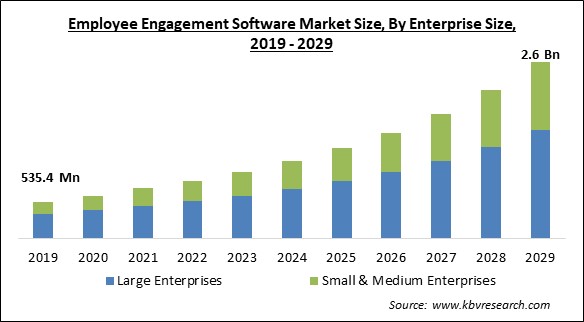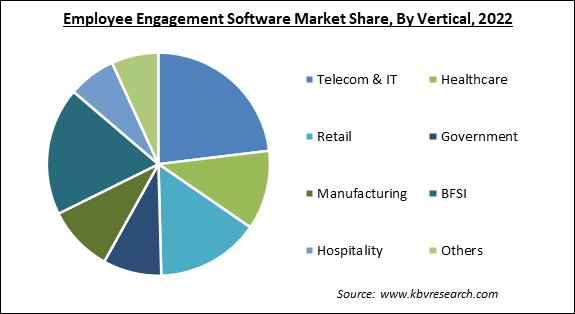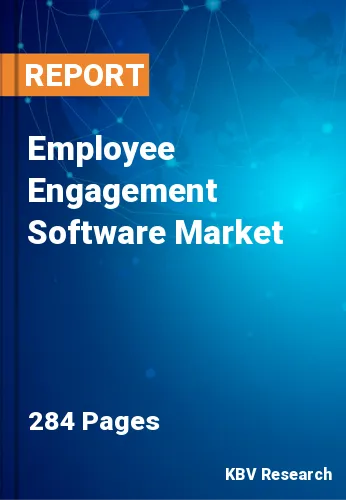The Global Employee Engagement Software Market size is expected to reach $2.6 billion by 2029, rising at a market growth of 17.7% CAGR during the forecast period.
Organizations that use employee engagement software can solicit, track, and manage employee feedback. Additionally, a system like this helps companies to acknowledge staff accomplishments, support promising projects, understand employee attitudes, and learn essential lessons from employee feedback. The company's human resources division implements employee engagement software as a supplement to existing methods or as a replacement for them.

Employee engagement software also increases corporate growth and income and increases employee retention, easy communication, increased productivity, and enhanced customer service. In addition, rising employee resignation rates and poor management communication in all industries drive software demand. Hence, businesses are observing tremendous development in their sales, employee productivity, and customer happiness owing to the deployment of software.
Businesses may improve employee and organizational experiences and increase employee engagement with the help of employee engagement tools. HR departments frequently select platforms for employee engagement and put them into place by managers, IT, the C-suite, and other organization members under the direction of HR. Trust, honesty, reciprocal commitment, and communication between a company and its members are the foundation for employee engagement. Enhancing organizational and individual performance, productivity, and well-being is a strategy that raises the likelihood of business success.
Nowadays, every business is data-driven, particularly when it comes to employee engagement. Dynamic dashboards in engagement tools instantly identify business areas needing help and showcase departments or regions performing excellent work. Leaders can monitor the change in engagement after launching any staff initiative and adjust as necessary. An increase in the digitization of daily work in both commercial and public companies will drive the expansion of the market.
The COVID-19 pandemic impacted people's lives, livelihoods, and economies all around the world. The considerable changes in the working environment completely disrupted the employee experience. Employee engagement was first negatively influenced by pandemic worries in 2020. Nonetheless, the businesses started remote working and work-from-home policies with the use of cutting-edge equipment in response to strategic policies from governments throughout the world. The need for employee engagement software has increased due to the pandemic's growing requirement for sophisticated team management and communication solutions.
Due to the growing use of artificial intelligence (AI) and machine learning (ML), employee contact is becoming easier. AI and ML have the ability to enhance on-site and remote employee engagement by monitoring organization-wide performance in real-time, providing workers with 24/7 support, and optimizing learning and development outcomes. In addition to automating monotonous chores, offering individualized learning and development experiences, and removing bias through enhancing a company's diversity recruitment strategy, the increasing adoption of AI and ML technologies facilitates the extraction of insights from performance data.
Employees have access to tools that ease work duties in a digital workplace. In addition, the focus is placed on effective collaboration and enhanced interaction, which assists the employee in increasing productivity. The sophisticated program delivers behavioral analysis that aids in staff retention. The software solutions for employee engagement have a number of characteristics, such as tracking employees' overall performance to increase productivity and maintain security. In addition to monitoring keystroke logging, smart rules and alerts, live views, access conversations, and file transfer tracking, their adoption rate is boosted by such additional vital features. These factors associated with employee management software will surge the market growth.
Engagement software requires continual feedback and data to analyze an organization's employee engagement rate. Yet, completing surveys, providing feedback, and engaging in real-time conversations might consume employee-dedicated working hours. With extra responsibilities, the individual may experience burnout and discontent with the organization. Many employee engagement surveys provide feedback that reveals employee involvement but do not provide information that might help businesses take a proactive stance. Therefore, hamper the employee engagement software market growth.
Based on deployment, the employee engagement software market is segmented into cloud and on-premise. The on-premises segment dominated the employee engagement software market with maximum revenue share in 2022. This is due to the complete control of the software provided to the company with the use of an on-premises deployment. This enables managers to use employee data in accordance with organizational or operational requirements. Similarly, quick access to information, resources, and other tools raises employee engagement levels even further and thereby provides more growth opportunities for the segment.

On the basis of enterprise, the employee engagement software market is divided into large enterprises and small & medium enterprises. The small & medium enterprises segment procured a substantial revenue share in the employee engagement software market in 2022. This is due to the fact that many small businesses have converted to permanent remote working, propelling the SME segment to a strong growth rate during the predicted period. Furthermore, software integration is anticipated to improve company communication and employee appreciation.
By function, the employee engagement software market is classified into onboarding, training, collaboration & interaction, customer service, rewards & recognitions and others (surveys). The training segment garnered a prominent revenue share in the employee engagement software market in 2022. This is because today's businesses place a strong emphasis on the professional growth of their staff members by providing them with interesting tools. In addition, training through engagement enables senior management levels to better handle and comprehend the challenges posed by employees and other obstacles.
Based on the Vertical, the employee engagement software market is bifurcated into retail, BFSI, government, healthcare, telecom & IT, hospitality, manufacturing and others (media & entertainment). The retail segment procured a promising growth rate in the employee engagement software market in 2022. This is due to the fact that the retail industry is expected to gain a considerable share as a result of the industry's increased focus on face-to-face communication with customers. Also, it is vital for the retail staff to be involved in their work and communicate well in order to boost employee satisfaction, thereby propelling the segment's growth.
| Report Attribute | Details |
|---|---|
| Market size value in 2022 | USD 840.6 Million |
| Market size forecast in 2029 | USD 2.6 Billion |
| Base Year | 2022 |
| Historical Period | 2019 to 2021 |
| Forecast Period | 2023 to 2029 |
| Revenue Growth Rate | CAGR of 17.7% from 2023 to 2029 |
| Number of Pages | 284 |
| Number of Table | 500 |
| Report coverage | Market Trends, Revenue Estimation and Forecast, Segmentation Analysis, Regional and Country Breakdown, Companies Strategic Developments, Company Profiling |
| Segments covered | Function, Vertical, Enterprise size, Deployment Type, Region |
| Country scope | US, Canada, Mexico, Germany, UK, France, Russia, Spain, Italy, China, Japan, India, South Korea, Singapore, Malaysia, Brazil, Argentina, UAE, Saudi Arabia, South Africa, Nigeria |
| Growth Drivers |
|
| Restraints |
|
Region-wise, the employee engagement software market is analyzed across North America, Europe, Asia Pacific, and LAMEA. The North America region led the employee engagement software market by generating the maximum revenue share in 2022. This is owing to the increased investment in digital solutions and HR tech tools. The region's nations are investing in employee-focused products to ensure the continuation of businesses and boost employee productivity. This region would present prospects for expansion due to the area's significant presence of major companies.
Free Valuable Insights: Global Employee Engagement Software Market size to reach USD 2.6 Billion by 2029
The market research report covers the analysis of key stake holders of the market. Key companies profiled in the report include 15Five, Inc., Degree, Inc. (Lattice), Smartly, Inc., Vantage Circle (Bargain Technologies Private Limited), Nreach Online Services Private Limited (Gift Management Asia Pte Ltd), Workvivo Limited, Synergita Software Private Limited (Aspire Systems Group), Leapsome GmbH, Kudos, Inc. and Culture Amp Pty Ltd.
By Vertical
By Enterprise Size
By Deployment Type
By Function
By Geography
The Market size is projected to reach USD 2.6 billion by 2029.
Usage of innovative technology like AI in the employee engagement software are driving the Market in coming years, however, Time consuming activities with improper feedbacks restraints the growth of the Market.
15Five, Inc., Degree, Inc. (Lattice), Smartly, Inc., Vantage Circle (Bargain Technologies Private Limited), Nreach Online Services Private Limited (Gift Management Asia Pte Ltd), Workvivo Limited, Synergita Software Private Limited (Aspire Systems Group), Leapsome GmbH, Kudos, Inc. and Culture Amp Pty Ltd.
The Large Enterprises segment acquired maximum revenue share in the Global Employee Engagement Software Market by Enterprise Size in 2022 thereby, achieving a market value of $1.6 billion by 2029.
The Collaboration & Interaction segment is leading the Market by Function in 2022 thereby, achieving a market value of $814 million by 2029.
The North America market dominated the Market by Region in 2022, and would continue to be a dominant market till 2029; thereby, achieving a market value of $953.8 million by 2029.
Our team of dedicated experts can provide you with attractive expansion opportunities for your business.

